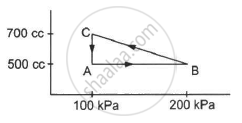Advertisements
Advertisements
Question
A gas is taken through a cyclic process ABCA as shown in figure. If 2.4 cal of heat is given in the process, what is the value of J ?

Solution
Heat given in the process, ∆Q = 2.4 cal
∆W = WAB + WBC + WCA
For line AB:-
Change in volume,
ΔV = 0
∴ WAB = 0
For line BC :-
Mean pressure, \[P = \frac{1}{2} \times (100 + 200) kPa = 150 \times {10}^3 Pa\]
\[ ∆ V = (700 - 500) cc = 200 cc\]
\[ W_{BC} = 150 \times {10}^3 \times 200 \times {10}^{- 6} \]
\[ W_{BC} = 30 J\]
For line AC :-
P = 100 kPa
ΔV = 200 cc
WCA = 100 × 103 × 200 × 10−6
Total work done in the one cycle is given by
∆W = 0 + 150× 103 × 200 × 10−6 − 100 × 103 × 200 × 10−6
∆W = `1/2` × 300 × 103 × 200 × 10−6 − 20
∆W = 30 J − 20 J = 10 J
∆U = 0 .............(in a cyclic process)
∆Q = ∆U + ∆W
⇒ 2.4J = 10
\[\Rightarrow J = \frac{10}{2 . 4} = \frac{100}{24} = \frac{25}{6} = 4 . 17 \text{J/cal}\]
APPEARS IN
RELATED QUESTIONS
Explain why Two bodies at different temperatures T1 and T2, if brought in thermal contact, do not necessarily settle to the mean temperature (T1 + T2)/2.
Should the internal energy of a system necessarily increase if heat is added to it?
The outer surface of a cylinder containing a gas is rubbed vigorously by a polishing machine. The cylinder and its gas become warm. Is the energy transferred to the gas heat or work?
Can work be done by a system without changing its volume?
Refer to figure. Let ∆U1 and ∆U2 be the changes in internal energy of the system in the process A and B. Then _____________ .

A gas is contained in a metallic cylinder fitted with a piston. The piston is suddenly moved in to compress the gas and is maintained at this position. As time passes the pressure of the gas in the cylinder ______________ .
The pressure p and volume V of an ideal gas both increase in a process.
(a) Such a process is not possible.
(b) The work done by the system is positive.
(c) The temperature of the system must increase.
(d) Heat supplied to the gas is equal to the change in internal energy.
Which of the following is correct, when the energy is transferred to a system from its environment?
Define heat.
A system releases 100 kJ of heat while 80 kJ of work is done on the system. Calculate the change in internal energy.
Explain the different ways through which the internal energy of the system can be changed.
When 1 g of water at 0° C and 1 x 105 N/m2 pressure is converted into ice of volume 1.082 cm3, the external work done will be ____________.
Two cylinders A and B of equal capacity are connected to each other via a stopcock. A contains a gas at standard temperature and pressure. B is completely evacuated. The entire system is thermally insulated. The stopcock is suddenly opened. Answer the following:
What is the final pressure of the gas in A and B?
Two cylinders A and B of equal capacity are connected to each other via a stopcock. A contains a gas at standard temperature and pressure. B is completely evacuated. The entire system is thermally insulated. The stopcock is suddenly opened. Answer the following:
What is the change in internal energy of the gas?
A person of mass 60 kg wants to lose 5kg by going up and down a 10 m high stairs. Assume he burns twice as much fat while going up than coming down. If 1 kg of fat is burnt on expending 7000 kilo calories, how many times must he go up and down to reduce his weight by 5 kg?
The molar specific heat of He at constant volume is 12.47 J/mol.K. Two moles of He are heated at constant pressure. So the rise in temperature is 10 K. Find the increase in internal energy of the gas.
A steam engine delivers 4.8 x 108 Jof work per minute and services 1.2 x 109 J of heat per minute from its boiler. What is the percentage efficiency of the engine?
Explain the change in internal energy of a thermodynamic system (the gas) by heating it.
